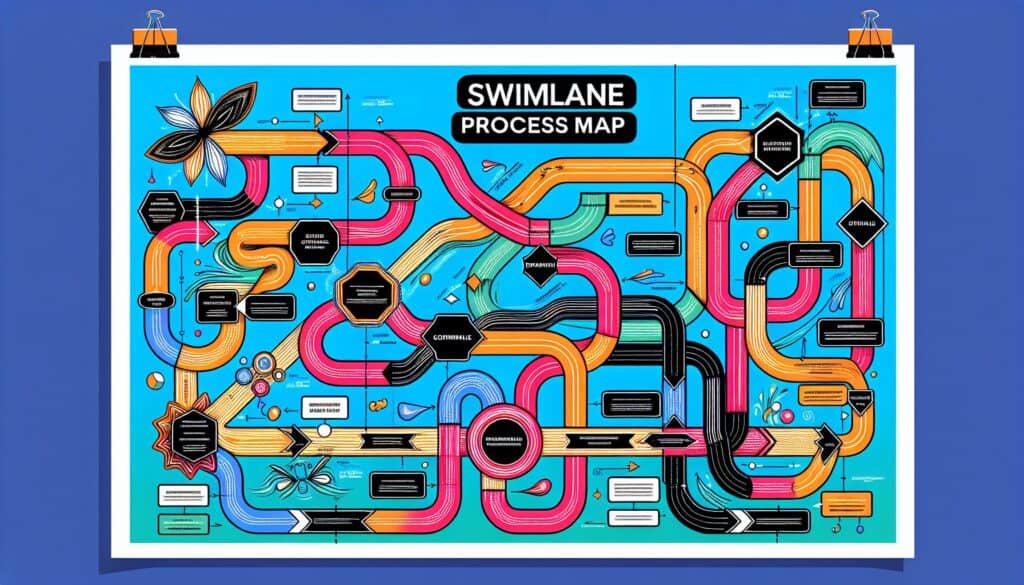Représenter le déroulement d'un processus, en délimitant clairement les responsabilités et les transferts entre les différents services, rôles ou systèmes.
- Méthodologies : Clients et marketing, Économie, Conception de Produits
Carte du processus de Swimlane

Carte du processus de Swimlane
- Business Process Reengineering (BPR), Amélioration continue, Collaboration interfonctionnelle, Production allégée, Amélioration des processus, Cartographie des processus, Optimisation des processus, Assurance qualité, Gestion de la qualité
Objectif :
Comment il est utilisé :
- Un type d'organigramme qui organise les étapes du processus en "couloirs" parallèles, chaque couloir représentant un acteur ou un domaine fonctionnel spécifique. Ce type d'organigramme permet de visualiser qui fait quoi et où se produisent les interactions.
Avantages
- Il montre clairement les rôles, les responsabilités et les transferts ; il aide à identifier les goulets d'étranglement, les redondances et les lacunes dans la communication entre les groupes ; il améliore la clarté et la compréhension des processus complexes impliquant de multiples parties prenantes.
Inconvénients
- Peut devenir encombrant s'il y a trop de voies ou d'interactions complexes ; peut nécessiter des efforts importants pour le créer et le maintenir, en particulier pour les processus qui évoluent rapidement ; se concentre principalement sur "qui" et "quoi", moins sur "comment bien faire".
Catégories :
- Ressources humaines, Fabrication, Résolution de problèmes, Conception de Produits, Gestion de projet
Idéal pour :
- Illustrer clairement la manière dont un processus traverse différents domaines fonctionnels ou rôles, en mettant en évidence les responsabilités et les interactions.
Les cartes de processus Swimlane trouvent leur application dans divers secteurs tels que la santé, la fabrication, le développement de logiciels et la finance, servant d'outil efficace lors de la conception et de l'amélioration des processus. Généralement utilisées pendant les phases d'analyse et d'optimisation des projets, ces cartes peuvent être initiées par des gestionnaires de projet ou des analystes de processus, et impliquer la participation d'équipes interfonctionnelles, qui peuvent inclure des parties prenantes des opérations, de l'assurance qualité et du service à la clientèle. Elles excellent dans la clarification des rôles et des responsabilités des différents acteurs d'un processus, ce qui les rend précieuses dans les environnements collaboratifs où plusieurs départements interagissent. Par exemple, dans un établissement de soins de santé, une carte des couloirs de navigation peut délimiter le flux d'informations sur le patient, de l'admission au traitement et à la sortie, en précisant les responsabilités du personnel infirmier, des médecins et du personnel administratif, tout en identifiant les lacunes en matière de communication susceptibles d'entraîner des retards dans la prise en charge. De même, dans le cadre du développement de produits, ces cartes peuvent décrire l'interaction entre les équipes de conception, d'ingénierie et de marketing, en mettant en évidence les redondances dans les transferts et en révélant les possibilités de synergie. Leur format visuel permet aux différents membres de l'équipe de discuter plus facilement de l'amélioration des processus, ce qui permet d'aligner les objectifs et de rationaliser les flux de travail entre les différentes fonctions de l'organisation.
Principales étapes de cette méthodologie
- Identifier les principaux acteurs impliqués dans le processus.
- Dresser la carte des principales étapes du processus pour chaque acteur dans son domaine d'activité.
- Définir les interactions et les transferts entre les voies.
- Clarifier les rôles et les responsabilités associés à chaque étape.
- Analyser le flux de travail pour détecter les goulets d'étranglement potentiels et les redondances.
- Répéter l'opération pour améliorer la clarté et la précision de la carte.
- Valider la carte Swimlane avec les parties prenantes pour obtenir un retour d'information.
- Finaliser le diagramme Swimlane pour la mise en œuvre et la communication.
Conseils de pro
- Incorporez des boucles de retour d'information dans vos cartes des voies de circulation pour améliorer l'adaptabilité et maintenir l'alignement entre toutes les parties prenantes au cours de l'évolution du processus.
- Utiliser codage couleur ou des symboles dans les couloirs pour distinguer visuellement les différents types d'activités, tels que les points de décision ou les retards, afin d'améliorer la compréhension rapide du flux de travail.
- Mettre régulièrement à jour la carte des voies de navigation pour refléter tout changement dans les rôles, les responsabilités ou les processus afin de garantir que le document reste une référence précise pour toutes les parties concernées.
Lire et comparer plusieurs méthodologies, nous recommandons le
> Référentiel méthodologique étendu <
ainsi que plus de 400 autres méthodologies.
Vos commentaires sur cette méthodologie ou des informations supplémentaires sont les bienvenus sur le site web de la Commission européenne. section des commentaires ci-dessous ↓ , ainsi que toute idée ou lien en rapport avec l'ingénierie.
Contexte historique
1949
1950
1950
1960
1960
1960
1960
1940
1950
1950
1958
1960
1960
1960
1960
(si la date est inconnue ou n'est pas pertinente, par exemple "mécanique des fluides", une estimation arrondie de son émergence notable est fournie)















Articles Similaires
Gestion des opérations de fabrication (MOM)
Système d'exécution de la fabrication (MES)
Plan de contrôle de la fabrication
Tests manuels
Tableaux d'évaluation des manutentions manuelles (MAC)
ManTRA (outil d'évaluation des risques liés aux tâches manuelles)